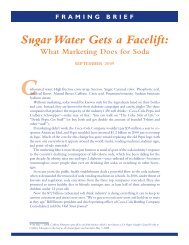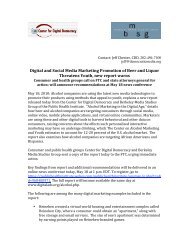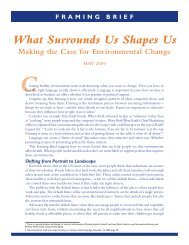"Interactive Food & Beverage Marketing" (PDF)
"Interactive Food & Beverage Marketing" (PDF)
"Interactive Food & Beverage Marketing" (PDF)
You also want an ePaper? Increase the reach of your titles
YUMPU automatically turns print PDFs into web optimized ePapers that Google loves.
African Americans are<br />
more likely to spread<br />
influence in<br />
homogenous African<br />
American networks,<br />
while Hispanics are<br />
more likely to get<br />
their influence from<br />
others outside their<br />
network.<br />
<strong>Interactive</strong> <strong>Food</strong> & <strong>Beverage</strong> Marketing | Appendix: Multicultural Marketing in the Digital Age<br />
While African Americans, according to the Multicultural Marketing Project, are<br />
good candidates for peer-to-peer and viral marketing campaigns (since “in-culture networking<br />
and word-of-mouth about products and commercial messages is much higher for<br />
AA [African Americans] than for anyone else”), “Hispanics are lowest in this attitude scale.<br />
What this means is that AA are more likely to spread influence in homogenous AA networks,<br />
while H are more likely to get their influence from others outside their network.<br />
This is a finding that has important implications for grass roots campaigns and the stimulation<br />
of word-of-mouth.” 34 But the diverse Hispanic “community”—immigrants from some<br />
20 different countries that have helped make the U.S. Hispanic population second only to<br />
Mexico in size—is no less active online. According to the AOL Latino 2006 Hispanic<br />
Cyberstudy, “Online communications among Hispanics goes well beyond email. Hispanics<br />
meet electronically with others in unusually high numbers. They visit chat rooms, send<br />
instant messages, read blogs and post to online message boards at far greater numbers<br />
than their online general population counterparts…. Based on our research, we also see<br />
that online Hispanics enjoy social networking online: 68% use instant messaging; 63%<br />
share photos online; 52% read or post blogs; 43% visit social networking sites; and 40%<br />
talk on a phone using the Internet.” 35 Mobile communications also come into play in<br />
reaching Hispanics with advertising. “In general,” observes Emily Burg, “Hispanics tend to<br />
respond better to SMS-based promos than online ones as the proliferation of mobile<br />
phones is higher among that population and is their most popular way of connection to<br />
the Internet.” 36<br />
Increasingly, as Hispanics spend more time online, advertisers are turning to<br />
new-media technologies to capture their attention. This community is seen as a crucial<br />
and growing new market online, as a new study entitled “Conexión Cultural/Connected<br />
Culture” makes clear. “Hispanics with Internet access outpace the general population in<br />
reported hours of daily media and technology use,” the report explains. Hispanic users<br />
regularly “utilize more than one device at a time.” 37 According to Michele Madansky,<br />
Yahoo vice president for global market research and co-author of the report, Hispanics<br />
are using all these media simultaneously. The Internet has really<br />
become central to their lives. The television is on all the time in the<br />
background, but the Internet is a critical part of their daily lives. Really<br />
it’s about how TV and Internet are being meshed. The Internet is not<br />
replacing the television, it’s enhancing the experience. 38<br />
As the fastest growing segment of the U.S. population, the Hispanic community<br />
is especially attractive to advertisers. “The term ‘ethnic marketing’ does not intrinsically<br />
include or exclude any group,” observes Jennifer Zegler, “but with 58 percent growth from<br />
1990 to 2000, and continually increasing, the burgeoning Hispanic steals the focus from<br />
other groups.” 39 According to the Census Bureau, Hispanics are also the youngest segment<br />
of the U.S. population, with a median age of just under 27 years (compared to 31<br />
years for African Americans and more than 40 years for non-Hispanic whites). Comprising<br />
14 percent of the U.S. population in 2004, Hispanics accounted for nearly half of the<br />
nation’s growth from 2000 to 2004. 40 Nor is there any lack of opportunities for advertisers<br />
to reach this coveted demographic, with some 75 cable networks, four broadcast networks,<br />
and 160 stations catering to Hispanics, along with a number of popular websites<br />
(led by AOL Latino and Yahoo! en Español). 41 Little wonder, then, that Kagan Research<br />
predicts that Hispanic advertising growth is expected to exceed that of the general market,<br />
reaching some $5.5 billion in gross advertising revenue by 2010. 42<br />
89









